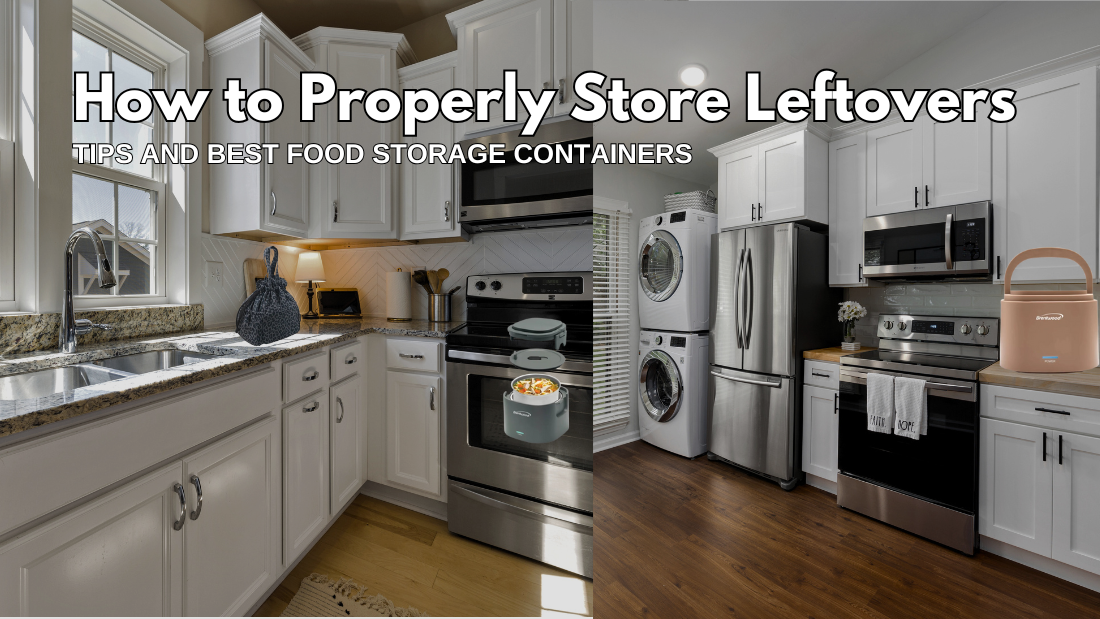Leftovers are the unsung heroes of our kitchens, offering an extra burst of flavor and a quick meal when time is tight. With a few smart tips and the right storage containers, you can keep your food fresh, safe, and delicious for days. In this guide, we break down practical, easy-to-follow strategies to store your leftovers properly while keeping your kitchen organized and your meals tasty.
Cool It Fast
After cooking, it’s important to cool your food quickly. Leaving hot dishes out for too long can give harmful bacteria a chance to grow. Transfer your food into shallow containers as soon as possible. Shallow containers maximize the surface area, allowing your food to cool faster and reducing the time it spends in the “danger zone” between 40°F and 140°F. Once the food is no longer steaming, cover it and pop it into the refrigerator.
Divide and Conquer
Dividing large portions into smaller, single-serving containers is a game-changer. Not only does it speed up the cooling process, but it also makes reheating a breeze. Instead of reheating an entire pot of soup or casserole, you can warm up just what you need. This approach minimizes repeated heating, which can degrade the quality and texture of your food over time.
Choose the Right Containers
The secret to long-lasting leftovers is in the container you use. Look for airtight food storage containers that prevent air from spoiling your food. Materials matter too—glass and BPA-free plastic are popular choices because they don’t leach chemicals into your food. They are safe for the refrigerator, freezer, and microwave (when used correctly), ensuring that your food stays fresh and ready to eat.
For those looking for a stylish and effective storage solution, check out the wide selection of top-rated food storage containers available at TotalFindz Food Storage Containers. Their collection features containers designed for durability and airtight sealing, making them perfect for any kitchen.
Label and Date Your Leftovers
A small step that makes a big difference is labeling your containers. Write down the contents and the date you stored the food. This habit not only helps you keep track of what’s in your fridge but also reminds you to use your leftovers within a safe time frame—generally three to four days for refrigerated items and up to two to six months for frozen foods. Labeling prevents waste and helps maintain food safety.
Store Foods Separately
Different foods have different storage needs. For instance, storing raw meats next to ready-to-eat vegetables can lead to cross-contamination. Always store leftovers in separate, clean containers, and use dedicated shelves for raw and cooked items. This strategy minimizes the risk of bacteria transferring from one food item to another.
Maintain the Right Temperature
Your refrigerator should consistently run at or below 40°F (4°C), and your freezer should be at 0°F (-18°C) or lower. Investing in an appliance thermometer helps you verify these temperatures. If your fridge is overcrowded, the airflow can be obstructed, causing some spots to be warmer than others. Organize your refrigerator so that air can circulate freely and food cools evenly.
Reheating with Care
When it’s time to enjoy your leftovers, proper reheating is key to food safety. Always reheat your food until it reaches an internal temperature of 165°F (74°C). Use a food thermometer to check the temperature in different areas of your dish. If you’re using a microwave, stir the food midway through reheating to distribute the heat evenly. Covering your dish with a microwave-safe lid or wrap can also help trap steam, ensuring that the food heats through without drying out.
Freeze for Longevity
If you don’t plan to consume your leftovers within a few days, freezing them is an excellent option. Freezing halts bacterial growth and can extend the shelf life of your leftovers for several months. Before freezing, portion your food into small, airtight containers or freezer bags. Remove as much air as possible from the bags, and label them with the contents and date. Remember that while freezing keeps food safe indefinitely, the quality may decrease over time.
Keep Your Containers Clean
Regular cleaning of your storage containers is essential to prevent odor buildup and cross-contamination. Wash them with hot, soapy water after each use. If your containers are dishwasher safe, use the top rack to ensure that they do not overheat or warp. Occasionally, inspect your containers for any signs of damage or staining; replacing worn-out containers can help maintain the freshness and safety of your stored food.
Avoid Using Foil for Long-Term Storage
While aluminum foil might seem like a quick fix, it doesn’t create an airtight seal and can lead to food spoilage. Foil also reacts with acidic foods, potentially affecting taste and safety. Instead, always opt for airtight containers or resealable plastic bags that lock in freshness and protect your food from air exposure.
Smart Kitchen Organization
A well-organized kitchen can transform how you store and manage leftovers. Use labels, clear containers, and stackable designs to maximize your storage space. Group similar items together and keep frequently used leftovers at eye level for easy access. An organized fridge not only saves time when you’re looking for dinner options but also minimizes waste by ensuring that older items are used before they expire.
Airtight Containers: The Best Friend of Leftovers
One of the most effective ways to keep your leftovers fresh is by using airtight food storage containers. These containers lock in moisture and flavor while keeping out the air that causes spoilage. They are versatile enough to handle everything from soups and stews to rice, pasta, and even baked goods. The quality of your container can significantly affect the longevity of your leftovers, so investing in high-quality options is worth it.
If you’re searching for reliable containers that combine durability with a sleek design, explore the collection at TotalFindz Food Storage Containers. Their range of products is engineered to keep your food fresh longer, reduce waste, and enhance your kitchen’s organization—all while adding a modern aesthetic to your storage solutions.
Plan Ahead for Meal Prep
Leftover storage doesn’t have to be a last-minute scramble. Incorporate meal prep into your weekly routine by planning ahead. Prepare and store individual portions of meals in advance, so you always have a quick option available. This method not only saves time but also encourages healthier eating habits by reducing the reliance on takeout. Use your airtight containers to pack balanced meals that you can easily grab from the fridge during busy mornings or hectic workdays.
Be Consistent with Food Safety Practices
Consistency is key when it comes to food safety. Follow these practices every time you store leftovers:
- Cool your food quickly by transferring it to shallow containers.
- Divide large portions into smaller, manageable servings.
- Label your containers with the date and contents.
- Use airtight containers to protect against air and moisture.
- Store foods at the correct temperature in your fridge or freezer.
- Reheat your leftovers thoroughly before consumption.
- Regularly inspect and clean your containers.
By making these practices a habit, you not only keep your food tasting fresh but also protect yourself and your family from foodborne illnesses.
Enjoy the Benefits
When you store your leftovers properly, you save money, reduce waste, and always have a delicious meal ready when you need it. Imagine opening your refrigerator and seeing a well-organized array of neatly labeled containers, each filled with food that’s as fresh as the day it was made. This level of organization not only makes mealtime stress-free but also transforms your kitchen into an efficient, well-oiled machine.
Final Thoughts
Storing leftovers doesn’t have to be a daunting task. With a few simple tips and the right containers, you can extend the life of your meals, reduce waste, and enjoy delicious food long after the main event. Whether you’re a busy professional, a meal prep enthusiast, or simply someone who loves a good second serving, following these tips will ensure that your leftovers remain safe, flavorful, and ready to eat.
Remember, the quality of your storage containers matters. For a wide range of options that combine style, durability, and airtight sealing, visit TotalFindz Food Storage Containers and upgrade your kitchen today.
By integrating these strategies into your routine, you take control of your food’s shelf life and contribute to a more sustainable and economical kitchen. Happy storing, and here’s to fresher, tastier leftovers every time!






